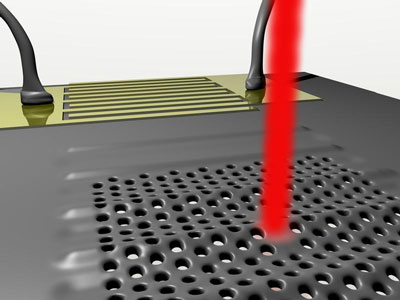| Oct 21, 2011 |
Sound gives nanocavity a twist
|
|
(Nanowerk News) Researchers from Augsburg, Munich and Santa Barbara (California) successfully combined the worlds of nanophotonics and nanomechanical systems. The scientists work for the cluster of excellence Nanosystems Initiative Munich (NIM), the Center for Nanoscience (CeNS), the Augsburg Center for Innovative Technologies (ACIT) and for the California NanoSystems Institute (CNSI) at Santa Barbara.
|
|
NIM graduate student Daniel Fuhrmann and his supervisor Hubert Krenner demonstrate in the latest issue of Nature Photonics ("Dynamic modulation of photonic crystal nanocavities using gigahertz acoustic phonons") that a sound wave can be used to control a photonic crystal. Quantum effects within the crystal lead to a fast and very efficient generation and modulation of single photons, the quanta of light. Hubert Krenner recently established a prestigious Emmy Noether Junior Research Group at the Chair of Achim Wixforth at Augsburg University.
|
|
For their experiments the team fabricated a freestanding nanomembrane of semiconducting material. Into the membrane they drilled a large periodic array of tiny holes using cleanroom nanofabrication. In this structure, a photonic crystal, they trapped light of a well-defined wavelength or color inside a region where they skipped three holes. As light emitters they placed so-called quantum dots inside of this nanocavity. These quantum dots are often called artificial atoms because they – just like real atoms – emit light at sharp spectral lines and as single quanta (photons).
|
 |
| Photonic crystal under the inluence of surface acoustic waves. These waves periodically stretch and compress the thin membrane and its precisely ordered array of holes.
|
|
Until now the key challenge in this system was to overlap the wavelength of the light trapped in the nanocavity and the light emitted by the quantum dot. When the two wavelengths are in resonance the quantum mechanical Purcell effect leads to a dramatic increase of the light extraction efficiency. The NIM-CNSI research team solved this problem very elegantly: the scientists used a nanoquake, so-called surface acoustic waves. These waves periodically stretch and compress the thin membrane and its precisely ordered array of holes. The nanoquakes deform the photonic crystal at radio frequency and the wavelength of the light inside the nanocavity oscillates back and forth in less than a third of a nanosecond. This is more than ten times faster than any other approach worldwide.
|
|
NIM-graduate student Daniel Fuhrmann is excited about the success of his experiments: "The idea of an acoustically modulated photonic crystal existed in our lab for quite a long time. After all the hard work it made me really proud to actually see the wavelength of the nanocavity oscillating with the shaking of the nanoquake. I am also very happy that we again have shown that surface acoustic waves, our special tool in Augsburg, lead to surprising results and outstanding research also in the field of nanophotonics"
|
|
The Augsburg group is renowned for their pioneering work and application of surface acoustic waves. They apply these to various types of nanosystems ranging from biological and biophysical systems over microfluidics to fundamental physical effect such as the Quantum Hall Effect. All these experiments have attracted large attention worldwide and built the outstanding reputation of their research using their nanoquakes on a chip.
|
|
The experiment by Daniel Fuhrmann and his colleagues from Bavaria and California is an excellent example for a successful international collaboration between the two high-tech states on both sides of the Atlantic Ocean. Hubert Krenner and Achim Wixforth both spent a long time at UC Santa Barbara and frequently visit their Californian colleagues. The project was seed-funded by the Bavarian-Californian Technology Center (BaCaTeC) and carried out supported by NIM within a PhD student scholarship of the Bayerische Forschungsstiftung (BFS).
|
|
Based on these groundbreaking experiments researchers expect that a highly efficient, acoustically triggered "single photon source" will be realized. Such a device is crucially required for inherently secure quantum-cryptography and the optical quantum computer.
|

